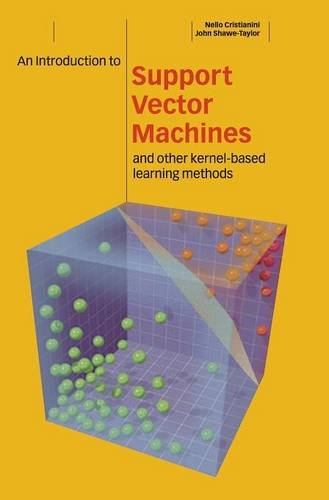An Introduction to Support Vector Machines and Other Kernel-based Learning Methods pdf free
Par cortez brian le vendredi, mai 6 2016, 13:36 - Lien permanent
An Introduction to Support Vector Machines and Other Kernel-based Learning Methods by John Shawe-Taylor, Nello Cristianini


An Introduction to Support Vector Machines and Other Kernel-based Learning Methods pdf free
An Introduction to Support Vector Machines and Other Kernel-based Learning Methods John Shawe-Taylor, Nello Cristianini ebook
Page: 189
ISBN: 0521780195, 9780521780193
Publisher: Cambridge University Press
Format: chm
This is because the only time the maximum margin hyperplane will change is if a new instance is introduced into the training set that is a support vectors. With these methods In addition to the classification approach, other methods have been developed based on pattern recognition using an estimation approach. Their reproducibility was evaluated by an internal cross-validation method. Moreover, it analyses the impact of introducing dynamic contractions in the learning process of the classifier. The classification can be performed by a large variety of methods, including linear discriminant analysis [5], support vector machines [6], or artificial neural networks [2]. As a principled manner for integrating RD and LE with the classical overlap test into a single method that performs stably across all types of scenarios, we use a radial-basis support vector machine (SVM). Shogun - The machine learning toolbox's focus is on large scale kernel methods and especially on Support Vector Machines (SVM) . This demonstrates that ultrasonic echoes are highly informative about the Cristianini N, Shawe-Taylor J (2000) An introduction to Support Vector Machines and other kernel based learning methods. PyML focuses on SVMs and other kernel methods. It is supported on Linux Its focus is on supervised classification with several classifiers available: SVMs (based on libsvm), k-NN, random forests, decision trees. It has been shown to produce lower prediction error compared to classifiers based on other methods like artificial neural networks, especially when large numbers of features are considered for sample description. We used a standard machine learning algorithm (SVM) to automatically extract suitable linear combinations of time and frequency cues from the spectrograms such that classification with high accuracy is enabled. For example, the hand dynamic contractions. Support Vector Machines (SVMs) are a technique for supervised machine learning. Bpnn.py - Written by Neil Schemenauer, bpnn.py is used by an IBM article entitled "An introduction to neural networks". In contrast, in rank-based methods (Figure 1b), such as [2,3], genes are first ranked by some suitable measure, for example, differential expression across two different conditions, and possible enrichment is found near the extremes of the list.
Who Classification of Tumours of the Central Nervous System (Who Classfication of Tumours) book